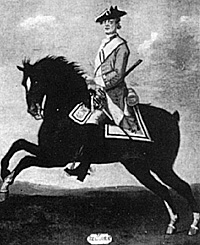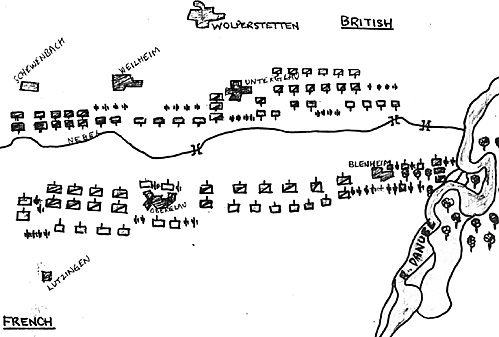 The Actual Battle
The Actual Battle
In the actual Battle, the main FrancoBavarian mistakes were that they had left a space of about half a mile between their front and the Nebel, on which the Allies could deploy; and the broad extent of open ground between Blenheim and Oberglau was held almost entirely by cavalry. Marlborough's plan was to capture Blenheim, roll up the enemy's line cutting off their retreat to Ulm, and to attack the centre, while Eugene's corps was to keep the French left fully occupied.
During the battle the Allied cavalry in the centre crossed the Nebel, thus utilising one of the French errors; the attack on Blenheim failed, but the village became isolated on the defeat of Tallard's centre and the retreat by Marvin on the left. The troops in the village were virtually annihilated.
The two Armies were:
Allies: About 52,000. 60 Guns
French and Bavarians: About 54,000.90 Guns.
Losses were:
Allies: 12,000 killed and wounded
French: 40,000 killed and wounded and
prisoners.
(The source was Marlborough's Campaigns by Captain F.d.O.Maycock D.S.O., a book in the "Special Campaign Series": Universal Press).
Blenheim as a Wargame:
French and Bavarians: Infantry 1,050: Cavalry 190
Allies: Infantry 900: Cavalry 220
The two armies were drawn up as on the plan. The main French concern was to deny the Allies the advantage of the wide gaps between the Nebel and themselves. This was a point in which tactically the battle was a great improvement on the French performance in 1704. Initially the French line was drawn up such a distance from the Nebel to form as straight a front as possible from Blenheim, to Oberglau and beyond.
The Allies, in the first move, attacked Blenheim across the Nebel from their right wing, but were scarcely across the stream when they were charged by three French squadrons drawn up between Blenheim and the Danube. The British were also badly mauled by 10 guns which the French had in and around Blenheim. The Allied right wing under Eugene was still not ready and would not be so for another move. Therefore the Allied centre remained inactive when Marlborough wanted a concerted effort to split the French down the middle. This could only be done if Eugene could attack and prevent Mersin sending reinforcements to Tallard in between Oberglau and Blenheim. The British continued their attack on Blenheim, and the French cavalry retired, leaving the still advancing British to be dealt with by the defenders in Blenheim.
 In the actual battle in 1704 these cavalry had charged after Row's Guards had made their first attack on the village, not before. The French cavalry now again showed its determination to hold the initiative and blunt any possible attacks of the Allies in good time by attacking all along the line, striking both the centre and Eugene's infantry now partly across the Nebel on the far right of the Allied line. In both cases, especially the centre, the French horse were well backed by infantry, 6 battalions moving up in the centre, and 4 on the
(French) left. But there were not enough French cavalry up front to strike decisively all the Allied attack, and two battalions of Eugene's command pushed on largely
unmolested towards Oberglau.
In the actual battle in 1704 these cavalry had charged after Row's Guards had made their first attack on the village, not before. The French cavalry now again showed its determination to hold the initiative and blunt any possible attacks of the Allies in good time by attacking all along the line, striking both the centre and Eugene's infantry now partly across the Nebel on the far right of the Allied line. In both cases, especially the centre, the French horse were well backed by infantry, 6 battalions moving up in the centre, and 4 on the
(French) left. But there were not enough French cavalry up front to strike decisively all the Allied attack, and two battalions of Eugene's command pushed on largely
unmolested towards Oberglau.
The Allies in the centre were now hit by the whole of the French centre. The 13 squadrons of Allied horse then were unable to deploy and only a part of them could engage the enemy cavalry. In fact, about 8 of these squadrons of the Allied centre were unable to move, being jammed between their infantry to their left and Unterglau to their right. These Allied infantry now moved against the French centre and for a time checked the enemy attack. But the French cavalry and 3 battalions of infantry, from Blenheim, now arrived as reinforcements and this extra weight proved too much for the Allies. Their infantry were now hopelessly outnumbered, about 9 French battalions to their 4, and still only part of the Allied cavalry was fighting, thus losing any advantage it may have gained from its great numbers. The French had, with the reinforcements from Blenheim, about 11 squadrons and 9 battalions.
The Allied cavalry on the right (Eugene) now had to charge the French left wing as it was making much progress against Eugene's infantry now, thanks to the promptness of the French cavalry on their left, caught astride the Nebel. Thus, though Eugene's cavalry eased the pressure on his infantry, they were delayed, indeed prevented at all, from co-operating with Marlborough in the centre. But, with ample infantry in and around Oberglau, the French sent another two battalions to support their cavalry so Eugene hardly got beyond the Nebel even with his horse (8 squadrons).
Meanwhile, by the 4th move, the Allies had called off their attack on Blenheim, with bad losses, and withdrawn across the Nebel. Over on the Allied left, too, Eugene's infantry, covered by another costly cavalry charge, withdrew across the Nebel.
The Allied centre, very crowded around Unterglau, was now in a bad way as the French sent out 2 battalions from Oberglau, meleeing and defeating the Allies still in the area from Eugene's earlier attack, and moved as if to cut Eugene entirely off from the centre and left. The Allied right pulled back even further, screened by the surviving cavalry, the left wing also, seeing at closer hand the sorry situation in their centre also retreated.
The French were unable to exploit the situation in the centre since the whole mass of French and Allies were so jammed that the French were unable to advance. The Allies, tightly jammed, stood their ground, and at last, more of their cavalry worked round Unterglau and were able to check the French infantry moving to split them and cut off Eugene. These French had already made some progress, having crossed a stone bridge over the Nebel and captured the battery in front of Unterglau. The French attacks, if not fizzling out, through stout rearguard action on the Allies' part, were deprived of any decisiveness and the Allied left and right, and some of the centre were able to withdraw and retiring in good order most managed to reunite under Marlborough and Eugene at Wolperstetten. The French, badly mauled, halted at Unterglau and along the Nebel.
The French had deprived the Allies, especially the cavalry in the centre of what may have been invaluable areas for deployment. By attacking promptly and (unlike the attack on Marlborough's cavalry whilst forming in 1704) in large numbers they took the initiative and largely cramped the Allies, preventing them from using their numbers of cavalry to the best effect. On the French right, Blenheim proved too strong anyway. The main contribution on their left was to draw the Allied cavalry under Eugene away from joining forces with Marlborough in the centre. Above all, the the French, superior in infantry, by making sure reinforcements went where they were needed were able effectively to feed their attacks. What lent such weight to the attack by their centre was that they had there a high preponderance of infantry over cavalry, the adoption of the reverse situation in 1704 having been one of their chief errors.
Though not an entirely accurate reproduction of Blenheim it seems to me that it takes alarming little adjustment in tactics by the French to produce somewhat different results than in 1704 when it is remembered how vital and crushing history has remembered Blenheim to be as an Allied victory.
The villages of Lutzingen, Schwenbach, Weilheim and Wolperstetten were not reproduced on the actual battlefield for lack of space and material.
The Armies' losses were as follows (no prisoners taken).
| Type | Allies | French |
|---|---|---|
| Infantry | 500 | 283 |
| Cavalry | 61 | 100 |
| Guns | 4 | 7 |
Map

Back to Table of Contents -- Wargamer's Newsletter # 114
To Wargamer's Newsletter List of Issues
To MagWeb Master Magazine List
© Copyright 1971 by Donald Featherstone.
This article appears in MagWeb.com (Magazine Web) on the Internet World Wide Web.
Other articles from military history and related magazines are available at http://www.magweb.com